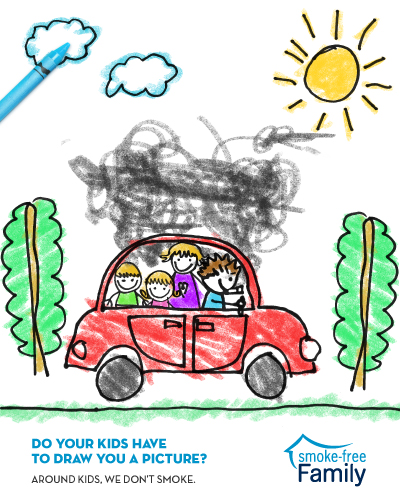
Montréal, May 25, 2016 – To coincide with the enactment of a series of measures related to the Tobacco Control Act, Smoke-Free Family is back with a new ad campaign primarily focused on the dangers of children’s exposure to second-hand smoke in cars and playgrounds. Note that the measures of the Act coming into effect tomorrow focus on prohibiting smoking in a vehicle when a child under 16 is present, as well as in outdoor children’s play areas, playgrounds, recreational camps and on sports fields.
The minister for Rehabilitation, Youth Protection, Public Health and Healthy Living and minister responsible for the Montérégie region, Ms. Lucie Charlebois, shared the following: “It is with great pleasure that I offer my support to the Smoke-Free Family campaign. The Act to bolster tobacco control, unanimously adopted last fall, allowed us to take a giant step forward by better protecting children from second-hand smoke that is harmful to their health. We can be proud of this progress and of this Act, which places Quebec among the global leaders in this matter.”
Dr. Christiane Laberge, spokesperson for Smoke-Free Family, notes that to safeguard children’s health, it is essential to avoid exposing them to second-hand smoke at all times. “The home should be a smoke-free zone, as should cars, where smoke can be particularly dangerous. The concentration of second-hand smoke particles in a vehicle can be up to 27 times higher than in a smoker’s home, and 60 times higher than in a non-smoker’s home1. Even with the windows down, the concentrations are unacceptable!” Dr. Laberge adds that even when smoking outside, in a park or while walking, second-hand smoke, even though it is less concentrated, can also pose a risk to children’s health if they are near the smoker.
The 2016 campaign signature is clear and underlines the fact that with all the known harmful effects of second-hand smoke on health, particularly on children’s health, it is unacceptable to smoke around them. Indeed, this toxic smoke contains over 7,000 chemical products including 70 that are known to cause cancer. Since children and babies breathe more quickly than adults and their immune system is not yet fully developed, they are even more at risk of suffering health problems when regularly exposed to second-hand smoke. Concretely, these health problems refer to bronchitis, pneumonia, asthma and recurrent ear infections. It is thus imperative that parents take concrete steps to protect the health of their little ones: make the home and their vehicle smoke-free zones and smoke far away from them at all times, even outside.
A quarter of Quebec smokers smoke at least occasionally in their car when a child under 16 is present2.
The smoke from 2 cigarettes with the windows closed and the air conditioning on generates a higher level of exposure to fine particles than the safe levels established by the WHO3. It is estimated that it would require “10,000 air changes per hour in an enclosed space such as a car to get rid of second-hand smoke”4.
Even though nearly 85% of second-hand smoke is invisible, it is just as toxic5.
Smoking in front of children can give the impression that it is “normal” and acceptable, which may make it more likely for them to try cigarettes.
Smoke-Free Family is an initiative of Capsana presented in collaboration with a network of public and private organizations, including Quebec’s Ministère de la Santé et des Services sociaux, the Quebec Directions de santé publique and Johnson & Johnson, with the support of the Canadian Cancer Society, Uniprix and CAA-Québec. To learn more about the campaign, visit smokefreefamily.ca.
1. California Environmental Protection Agency: Air Resources Board (2005). Proposed Identification of Environmental Tobacco Smoke as a Toxic Air Contaminant. http://www.arb.ca.gov/regact/ets2006/app3exe.pdf
2. Institut national de santé publique du Québec (2014). Fumer dans la voiture en présence d’enfants: comportements de fumeurs québécois et croyances au sujet d’une éventuelle loi, 22 septembre 2014, page 13.
3. Institut national de santé publique du Québec (2014). Fumer dans la voiture en présence d’enfants: comportements de fumeurs québécois et croyances au sujet d’une éventuelle loi, 22 septembre 2014, page 12.
4. James Repace, quoted in a study by the Institut national de santé publique du Québec: La fumée de tabac secondaire, effets sur la santé et politiques de contrôle de l’usage du tabac dans les lieux publics, 2006, p. 46. https://www.inspq.qc.ca/pdf/publications/487-FumeeTabacSecondaire.pdf
5. Cancer Research UK (n. d., mise à jour 23 mars 2015). Passive smoking. http://www.cancerresearchuk.org/about-cancer/causes-of-cancer/smoking-and-cancer/passive-smoking
Capsana is a social enterprise owned by the ÉPIC Foundation and the Fondation PSI, which are associated with the Montreal Heart Institute. Its mission is to help individuals take an active role in their health.
© 2025 Capsana – All rights reserved | Privacy policy | Sitemap